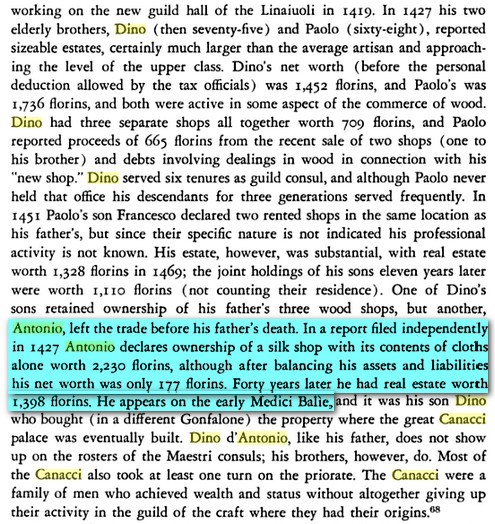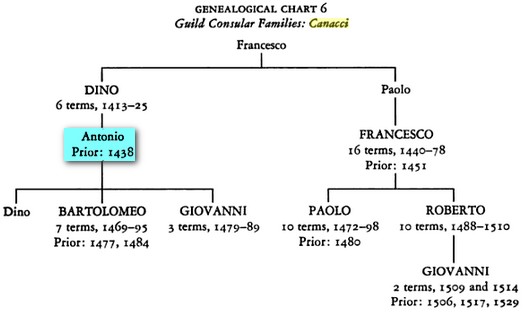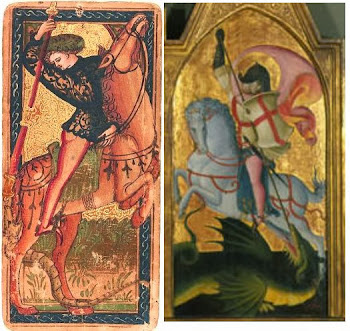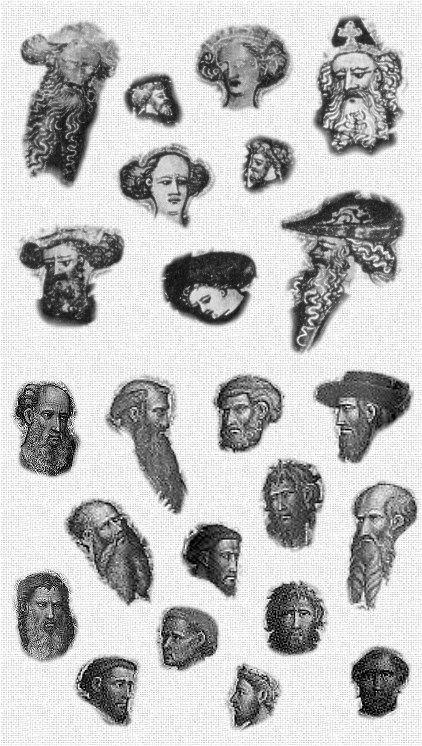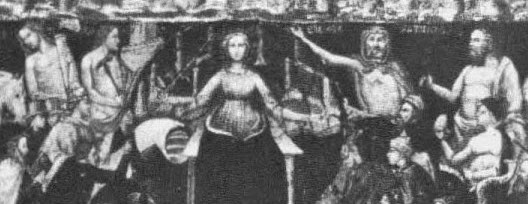I do not want to discuss the Florentine origin of the cards. In that regard Ross was in full agreement with her points, and so am I. I want to make it clear that I do not wish to defend either Ross or Fiorini, but rather to pursue that elusive quarry, the Truth. I will also be going over some material that Huck posted about da Ponte.
Here are the issues I want to discuss.
1. Are these cards really part of a tarot deck, or perhaps for some other game, notably Emperors?
2. How do the cards compare with the dal Ponte cassoni paintings of which we have record?
3. How does the Knight of Batons relate to the dal Ponte "St. George" of a similar design? This is a point of dispute between Fiorini and Ross.
4. How do the faces in da Ponte paintings compare with the faces on the cards? This is another issue raised by Ross.
5. Can the style of the cards be dated specifically to the 1420s as opposed to the 1450s-1460s? Fiorini tries to deal with this issue first, but without actual images it is difficult to discuss. I put it last because by then we will have seen at least a few of his works and those of others.
In this post I am only going to deal with points 1 and 2, because they go together and I think that it will be is enough for one post. I am not going to give a full discussion of question 2, But just assemble some data and images relative to cassoni and cardmakers, and discussone cassone panel, the Triumph of Fame.
1. The Ferrara note on the game of Emperors is at http://trionfi.com/0/p/06/#a. It specifies
The "gilded" part fits the Rothschild cards. The date and place is consistent with Fiorini. Further investigation is needed. Perhaps considerations in points 2-5 will be relevant to this point 1.one pack of cards of VIII Emperors gilded, which was brought from Florence for Milady Marchesana which Zoesi servant of said Lady had; priced 7 florins, new, and for expenses (of the transport) from Florence to Ferrara 6 Bolognese soldi; in all valued….. L. XIIII.VI. Bolognese
2. On his cassoni, I will start with documentation. There is more than one might expect, because he was frequently in trouble with his creditors. There are several dated lists of debts and credits, with descriptions of the goods, names, ages, etc. documented in English by Horne in "Giovanni da Ponte", Burlington Magazine 9:41 (Aug. 1906), pp. 332-337, available in Jstor, including many cassoni, around ten, I think. As far as the number that are still extant, it is difficult to say, because in most cases the panels have been separated. I will either show or give links to eight separated panels and one complete cassone (in a private collection) that I have found so far. None of these lists mention cards of any sort.
2A: DOCUMENTS
In March of 1422 he is paid 25 florins for two forzieri, chests, done for Ilarione de' Bardi on the occasion of her niece Constanza's marriage to Bartolommeo di Ugo degli Alessandri (p. 334). This had been documented earlier by Gamba (Rassegna d'Arte vol. iv p. 186). Fiorini makes much of this pair of cassoni. But there were others. three of which, 1427-1433, Horne found himself in the Florence archives. He says the documents will be published soon in the Italian journal.
In 1424 he is put in prison for 8 months for non-payment of debts, after which he works out an agreement with his creditors to pay them off over 5 years.
In 1427, there is owed to him (p.335) :
This time dal Ponte is mentions a wife. Monna Caterina; he also has an older subsidiary partner, Smeraldo di Giovanni (born 1366 (vs. 1385 for dal Ponte), who gets less of the profits but has "no obligation to pay rent". He has a shop with residence above at the Piazza of Santo Stefano a Ponte (hence his trade name, Giovanni da Santo Stefano a Ponte).Giovannozzo and Paolo Biliotti, for the forzieri [or wedding chests],of their sister whom they married to one of the Gondis,.30 florins.
This Smeraldo has his own "denuncia" statement, in which he says (p. 337):
In 1430, da Ponte states (p. 336):Matteo degli Strozzi owes us for the balance on a pair of forzieri, or chests, which he had from us on the 6th May, 14 florins or thereabouts; and Zanobi di Bartolommeo Banchebi owes us 22 florins for the balance on a pair of forzieri.
Horne identifies this Luca as Luca di Matteo Firidolfi da Panzano, because a 1449 inventory of his furniture included "Uno forziere dorato bello".we are making for Bardo di Francesco de' Bardi, a pair of forzieri or chests; what is executed amounts to 50 florins.
Moreover, we have begun to re-cover with gosso [preparatory for the painting] forzieri, or chests, which are the property of Luca di Matteo and Antonio di Martino.[what is executed amounts to] 4 florins.
Also they are owed the balance on chests from
There is also an entry stating they are owed from:"Zanobi di Gherardo Cortigiano and his brothers, for the balance of forzieri.
Antonio di Dino, who worked with the said Nanni, 20 florins.
I have no idea who "Nanni" is. It would appear, given that it occurs with the item about the chests, that Antonio owes da Ponte the 20 florins. Horne adds:
That's 1441, I think. For the same year, there follows a list of 3 painters, among others, who owe him money and others whom he owes, including one "Salvestro di Dino, forzerinaio." (A chest-maker?)This 'garzone' of Giovanni's was born in 1402 and after became a "maestro di tavoli di gesso". His name occurs in the old roll of the Campagna di San Luca, fol. 3 tergo, thus: Antonio didino dipintore mccccxxxxi.
After that, I don't see mention of any more cassoni or Dinos, just churches (which also were in evidence in 1430). That makes sense. He has come up in the world, at least in prestige. Art in churches is seen by more people, and in those days is likely to endure longer, than art for people's private use. The last "denuncia" is 1435. On November 19, 1437, dal Ponte "executes a codicil to his will". About this Horne adds (p. 337):
The reason for this is that from 1427 (or perhaps 1430) through 1435 the "denuncias" were joint ones, concerning both Giovanni and his partner. In 1442 there is one for the partner alone, in which he says he has sold everything and no longer works. Now 76 years old, he lives on the income of a person whom he had assisted in the past who is now returning the obligation.Milanese in his notes to Vasari, ed. Sansoni, vol. 1, p. 633 note states that Giovanni died in 1437. This statement appears to be founded on a conjecture drawn from the document last cited. If Vasari's statement, that the painter died in his fifty-ninth year, then Giovanni would have survived till 1444. It would seem, however, that he was already dead in 1442.
In relation to persons mentioned in the 1430 "denuncia", I see from Huck (viewtopic.php?f=11&t=858&p=13292&hilit=Dino#p13292):
I'd like to know how it is determined that this Antonio di Dino is a different person from the cardmaker Antonio di Dino that comes up in Franco's studies, starting in 1441 and making triumph decks in 1452. I don't see that being called a "maestro di tavoli di gesso" (a plasterer?) excludes him from being a cardmaker. We are not dealing with medieval trades here, just medieval guilds. So if an engraver is a member of the goldsmith's guild, why can't a wall-decorator--someone who paints decoration, perhaps considered their version of wallpaper--be a member of the plasterer's guild? Also, he is called "dipintore" in 1441. Da Ponte had had a similar entry himself in 1408, in the same Compagna: "Giovannj dimarcho dipentore mccccviij". The date was subsequently altered to "mccccxii", but, Horne says, "the earlier year was probably that of the painter's entry into the company".It was a suspicion, that Filippo di Marco might be a brother to Giovanni di Marco (= Giovanni dal Ponte), but it couldn't be confirmed.
It was another suspicion, that an Antonio di Dino, who owed money to Giovanni dal Ponte in 1428, was the cardmaker Antonio di Dino, who worked for the silk dealers in Florence, but this was definitely another "Antonio di Dino".
So none progress with the question "Was Giovanni dal Ponte a cardmaker or not".
Also, does "garzone" ("boy") here mean son, apprentice, or what?
Then there is this Filippo di Marco, same last name as our dal Ponte (which is his trade name, for where his shop was), as well as 2 decks in 1434 I didn't know about. Franco (or is it Huck?) observes:
I'd like to know more about the 2 decks in 1434, too. Where, when, who, what?In Filippo di Marco's productions the number of decks is not clear. So it isn't part of of the calculation. Two records refer to Florentine productions, which were sold to Ferrara (Imperatori cards in 1423, 2 other decks in 1434). These are not considered, cause they fit more with the generally expensive handling at the Ferrrarese court.
2B: IMAGES
Now I will turn to the cassone paintings. Of these the most important for our purposes is a "Triumph of Fame", whereabouts unknown but for which there is a black and white photo. If you see diagonal lines, I apologize; I scanned it at too low a resolution, and now the book is long gone back wherever it came from via Interlibrary Loan. I get this from Callman, Apollonio di Giovanni (it is also in an Italian essay by Malke). Callman says that it is "1420s or 1430s" (p. 12).
Fiorini observes:
I see no similarity between the Rosenwald Emperor and the figure of Fame. She probably meant to compare the Rosenwald Empress and the figure of Fame (or else I mistranslated). Here are all four Rosenwald "papi", followed by a detail from the Triumph of Fame:Si notino, in particolare, le somiglianze fra l'Imperatore Rothschild e l'Imperatrice Rosenwald e quelle fra il Re di Bastoni Rothschild e Imperatore della serie americana (questi ultimi tra l'altro molto simili alla figura della Fama dipinta da Giovanni di Marco sul cassone raffigurante il Trionfo di quella Virtù.
(Notice, in particular, the similarities between the Rothschild Emperor and the Rosenwald Empress, and those between the Rothschild King of Batons and the Emperor of the American series (the latter of which is quite similar to the figure of Fame painted by Giovanni di Marco on the chest depicting the Triumph of that Virtue.)
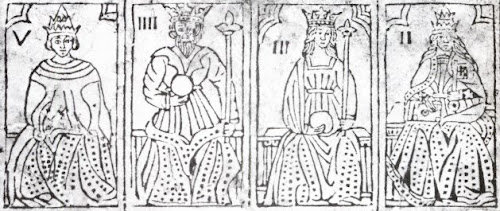

For further comparison, here is the Rothschild Emperor. The image comes from Berti and Vitali, Tarocchi: Arte e Magica, p. 27:
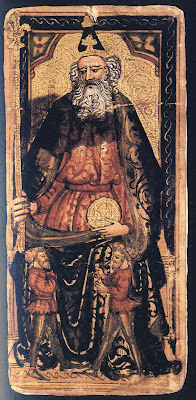
I see some similarity between this figure, as well as the two smaller figures at his feet, and the bearded figure immediately to Fame's left and above the man with the papal tiara. These all could be the same artist, it seems to me, but I am no expert. They could also have been done by someone later who had worked for da Ponte and took over his sketches. Such a person would not likely have had access to the cassone itself, being for a lady's private use
There is also another similarity, that between Fame, with her two grooms, and the Catania/Allesandro Sforza Charioteer and similarly positioned grooms. The faces, while both somewhat ambiguous in gender, are different. I suspect that a wider face is thought of as more masculine. Also, the horses are pointing differently, looking at each other, as in the case of the Cary-Yale, but like the Catania they are symmetrical with each other. The Catania Charioteer--as well the Rosenwald Empress--might be descended from the cassone painting. Since cassoni were private, this might have been difficult unless there were a more public version, such as a playing card or a sketch.
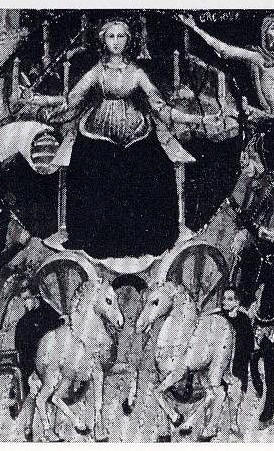

Also speaking in favor of da Ponte's having done triumphs, as opposed to other sorts of decks, are the general themes that dal Ponte took up for his cassoni: the seven virtues, Petrarch, Dante, a triumph. These are themes of the tarot as well. "Giovanni dal Ponte was interested in subjects of an allegorical sort," one writer has observed (Edward Kennard Rand, on p. 31 of "Dante and Petrarch in a Painting by Giovanni Dal Ponte", in Notes (Fogg Art Museum), 1:3, (Jan. 1923), pp. 25-33; in Jstor).
Rand's example is three panels that he thinks might have all been part of one cassone at one time. One part has the theme of the seven virtues, each with a patron and an angel. In a unclear image, it is at http://fe.fondazionezeri.unibo.it/foto/ ... /33110.jpg.
Another part is the "seven liberal arts" (image from http://jeannedepompadour.blogspot.com/2 ... -1500.html).

And then on one end Rand puts this painting of Dante and Petrarch (from wikimedia commons)::
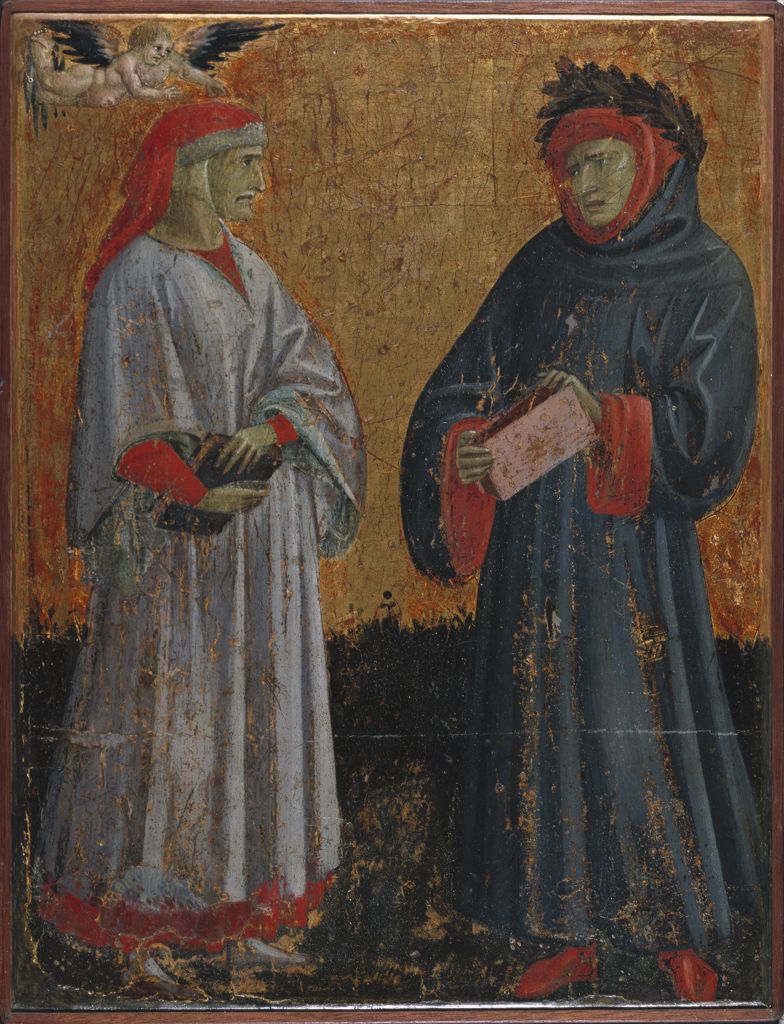
Rand suggests for this last the theme of sacred vs. secular poetry. That also separates the four cardinal from the three theological virtues. Rand has a nice analysis of who the figures are accompanying which liberal art in the other panel, and similarly for the virtues, if anyone is interested.
The Fondazione Federico Zeri has a nice list of 77 of dal Ponte's works of all types, most with pictures, at: http://www.fondazionezeri.unibo.it/cata ... lizzazione. Here are links to other cassone paintings they show.
"Giardino d'Amore" at the Musée Jacquemart-André in Paris, viewable at http://fe.fondazionezeri.unibo.it/catal ... 39%3bamore.
"Corte Nuziale", http://www.fondazionezeri.unibo.it/cata ... eo+nuziale
"Scena di duello, Scena di caccia," http://www.fondazionezeri.unibo.it/cata ... +di+caccia
"Scene da una leggenda"; this is the sole undivided cassone attributed to dal Ponte (by Christies, at least), in a collection in La Spezia and known to us by its auction photo: http://www.fondazionezeri.unibo.it/cata ... a+leggenda
Finally, from either a cassone or a "spalliera" (wall panel): "A Nobleman and a Lady" at http://www.mutualart.com/Artwork/A-nobl ... AB9DE6BF12.


